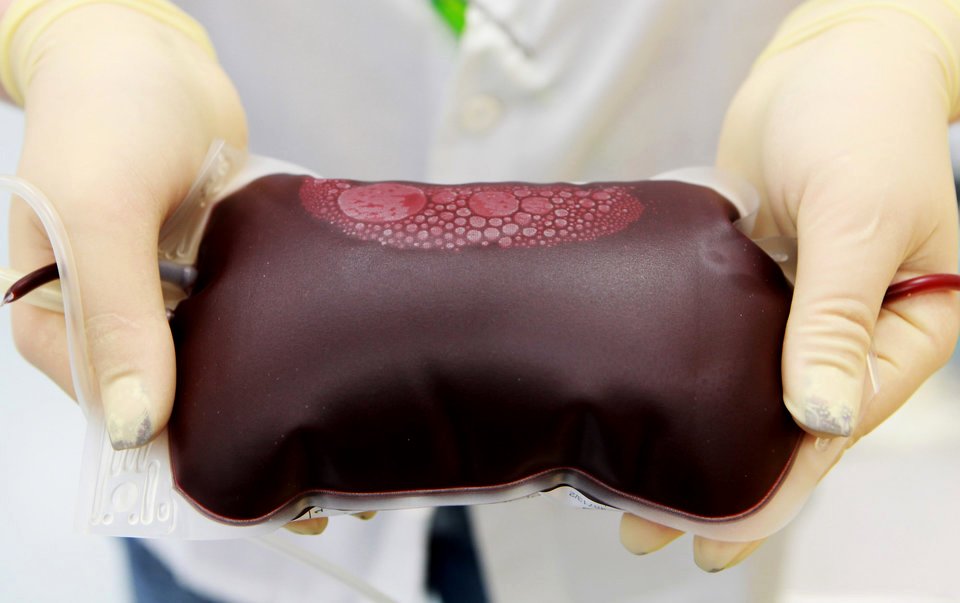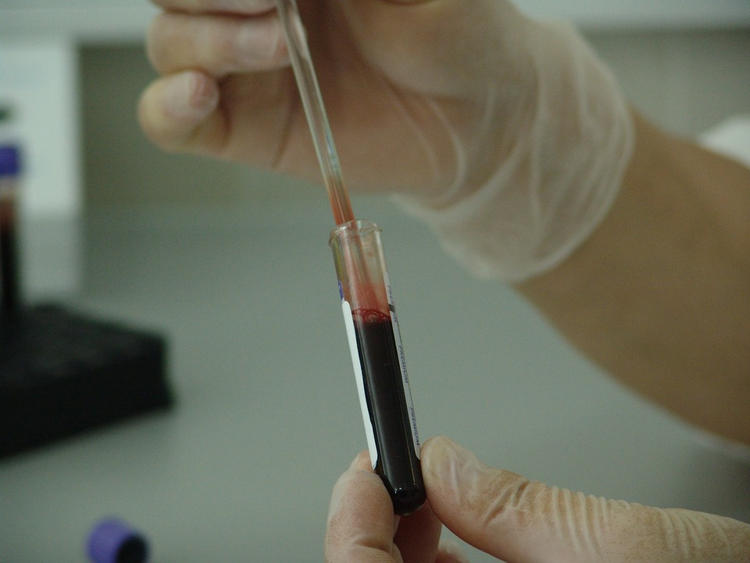

On this month's Oddities in the News Page:
A brand new practice of transferring young people's blood into old people--is it the fountain of youth?
IN THE ODDITIES ARCHIVES
Artificial Intelligence Newscaster
Harvard University UFO
Loch Ness
Clone
Donald Trump Look-Alike
A Real Killer Clown

Ambrosia, the Controversial Treatment That Allows Older People to Fight the Effects of Aging with Young Blood
January 3rd, 2019 -- Blood transfusions have been used to save lives for decades, but now one startup wants to use the medical procedure to combat the effects of aging by injecting older people with young blood. The treatment is called “Ambrosia”, after the mythological food of the Greek gods, which granted whoever consumed it longevity or immortality.
It only takes two hours to have two liters of plasma from donors aged 16 to 25 into your body, but according to Ambrosia founder Jesse Karmazin, the results are nothing-short of miraculous. He once called it “plastic surgery from the inside out“, told one reporter that while the transfusion doesn’t grant immortality, it “comes pretty close”, and told another journalist that just one infusion of young blood “dramatically improves people’s appearance, their memory and their strength”. The company even ran a medical study that officially ended in January of 2018, but despite boasting about its “really positive” results, Ambrosia Medical has yet to make those results public. And that’s what makes this treatment so controversial in the eyes of many health experts – no one has ever offered any solid proof of its efficacy.
34-year-old Karamazin founded Ambrosia Medical in 2016, after graduating from Stanford Medical School. He got the idea for infusing young blood into older people with the goal of stopping or at least slowing down the effects of aging, after reading several studies in which young and old mice were surgically conjoined in order to observe the effects of mixing their blood. Researchers reported cases in which the older mice became temporarily stronger and exhibited slightly improved health, and Karamazin was confident that these same type of result could be replicated in humans.
In the summer of 2016, Jesse Karmazin announced that he would start charging people 35 and over $8,000 to participate in a “clinical trial” where they would be injected with about 2 liters of plasma from young donors. Believe it or not, he didn’t have to get an approval from the Food and Drug Administration, as this was technically a simple transfusion, the well-established medical procedure that has been performed for many decades. The only difference here was the goal. Instead of using transfusion to treat serious health conditions, Ambrosia Medical was promoting it as an anti-aging treatment.
“There are pretty much people from most states, people from overseas, people from Europe and Australia,” Karamazin told CBS. But finding blood banks willing to provide dozens of gallons of young blood was tricky, as blood banks didn’t separate blood by age or sell it for rejuvenation purposes. However, he was eventually able to find a couple of partners and Ambrosia Medical reportedly performed more than 150 transfusions, with some patients returning for multiple treatments. The clinical study ended in January of last year, but the company has yet to make the results public. Karamazing recently told the Huffington Post that he was eager to share the results with the world, and would eventually publish them in a peer-reviewed journal, but didn’t specify when.
In 2017, Ambrosia enrolled people in the first US clinical trialdesigned to find out what happens when the veins of adults are filled with blood from the young.
While the results of that study have not yet been made public, Karmazin told Business Insider the results were "really positive."
Because blood transfusions are already approved by the Food and Drug Administration, Ambrosia's approach has the green-light to continue as an off-label treatment. There appears to be significant interest: since putting up its website last week, the company has received roughly 100 inquiries about how to get the treatment, David Cavalier, Ambrosia's chief operating officer, told Business Insider. That led to the creation of the company's first waiting list, Cavalier said.
"So many people were reaching out to us that we wanted to make a simple way for them to be added to the list," Cavalier said.
With that in mind, Cavalier and Karmazin are currently scouting a number of potential clinic locations in New York City and organizing talks with potential investors. They hope to open the facility by the end of this year.
"New York would be the flagship location," Karmazin said.
But as far as young blood is concerned — and its alleged potential to fight aging — the science remains unclear.
"There's just no clinical evidence [that the treatment will be beneficial], and you're basically abusing people's trust and the public excitement around this," Stanford University neuroscientist Tony Wyss-Coray, who led a 2014 study of young plasma in mice,recently told Science magazine.
What about drinking blood?

Live Science says: In very small amounts (say, a few teaspoons), and if the blood is free from pathogens (such as the many blood-borne diseases), blood might not harm you. Beyond that, watch out.
The strange fact is, blood, when drank, is toxic. When confined to places where blood is supposed to be — such as the heart, vessels, and so on — it is essential for life. But when ingested it's a very different story. Of course all toxins have doses, and just as a tiny bit of poison won't necessarily harm you, the more you eat or drink, the greater the danger.
Because blood is so rich in iron — and because the body has difficulty excreting excess iron — any animal that consumes blood regularly runs a risk of iron overdose. While iron is necessary for all animals (and indeed most life), in high doses it can be toxic. This condition, called haemochromatosis, can cause a wide variety of diseases and problems, including liver damage, buildup of fluid in the lungs, dehydration, low blood pressure, and nervous disorders.
See more HERE
But there are modern-day people who call themselves Vampires. Below is a photo of two of them.

People who claim to be vampires are in the thousands, with demographics transcending class, race and gender. But there’s a reason they stay in the shadows.
Drinking blood isn’t what Hollywood makes it out to be, according to real-life vampires.
"We do not identify with fictional characters, supernatural powers, or immortality, nor do we have any difficulty distinguishing between fantasy and reality."
First of all, there’s no biting – that’s neither safe nor sanitary – and with too many vital arteries, the neck isn’t the favored spot. Transactions aren’t carnages leaving the victim lifeless behind in a dark alley, and nor do vampires sleep in coffins or burn in daylight. They’re generally cool with garlic. Most of them don’t even have fangs.
Instead, modern vampires get their sustenance from inch-long incisions made by a sterilized scalpel on a fleshy part of the body that doesn’t scar. Though the vampire may suck it up directly from the source, medically trained personnel usually perform the procedure. There’s paperwork too: “donors” don’t just have to consent, but also provide health certificates proving the absence of blood-borne diseases. Still, feeding is a sensual and sacred ritual, according to those who partake.
See more HERE
And then there was Elizabeth Bathory...did she take baths in virgin's blood to seek the fountain of youth?

Countess Elizabeth Báthory de Ecsed (Hungarian: Báthory Erzsébet ; 7 August 1560 – 21 August 1614) was a Hungarian noblewoman and alleged serial killer from the noble family of Bathory. She has been labeled by Guinness World Records as the most prolific female murderer, though the precise number of her victims is debated. Báthory and four collaborators were accused of torturing and killing hundreds of young women between 1585 and 1609.
The highest number of victims cited during Báthory's trial was 650. However, this number comes from the claim by a serving girl named Susannah that Jakab Szilvássy, Countess Báthory's court official, had seen the figure in one of Báthory's private books. The book was never revealed, and Szilvássy never mentioned it in his testimony. Despite the evidence against Elizabeth, her family's influence kept her from facing trial. She was imprisoned in December 1610 within Čachtice Castle, in Upper Hungary (now Slovakia), and held in solitary confinement in a windowless room until her death four years later.
The stories of her serial murders and brutality are verified by the testimony of more than 300 witnesses and survivors as well as physical evidence and the presence of horribly mutilated dead, dying and imprisoned girls found at the time of her arrest. Stories describing her vampire-like tendencies (most famously the tale that she bathed in the blood of virgins to retain her youth) were generally recorded years after her death, and are considered unreliable.
See more HERE
